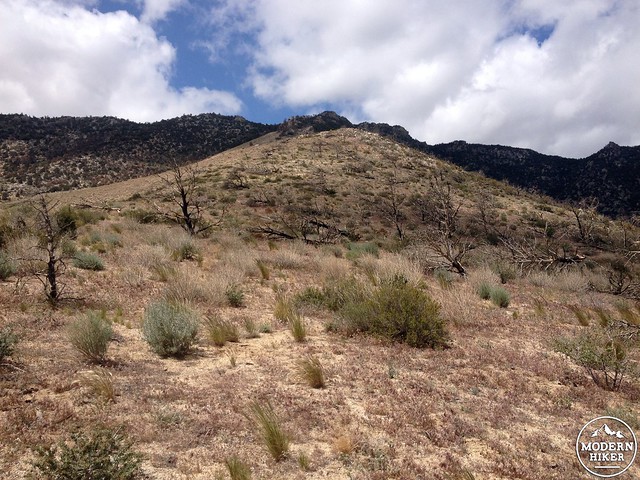Scodie Mountain is the highest peak in the Scodie Mountain subrange of the southern Sierra Nevada mountains. While this peak doesn’t qualify as a classic, the solitude and views easily make it a worthwhile objective if you are looking for a half-day adventure. There are no established trails to the top so whichever route you choose will involve off-trail travel, often times on loose sand or scree. The northeast ridge is the route described here, but other options include Cow Heaven via the south side or from the Pacific Crest Trail to the northwest.
Note: This map renders additional distance on this route for some reason. The GPX is accurate at 6.9 miles roundtrip.
The northeast ridge has required sections of 3rd class scrambles with brief exposure, however the biggest difficulty is route finding through occasional sections of dense pinyon pine.
Don’t let these challenges sway you from doing this hike. This peak provides a somewhat rare opportunity to reach a prominent summit with views up the Owens Valley without the crowds found on nearby trails. In fact, you will probably have the mountain to yourself. According to the summit register, there are only around four summit parties each month!
For the northeast ridge, park along Highway 178 at a large dirt parking lot found on the southern side of the road, 6.8 miles from Highway 395. The GPS tracks begin a little farther to the north since I didn’t notice this parking lot until partway up the climb.
You will be traveling through the Kiavah Wilderness (established under the Desert Protection Act of 1994) in Sequoia National Forest. Begin by following an old dirt road 0.6 miles to the south. The road will take a sharp turn to the left and drop into a wash — this is your landmark to leave the road and begin a direct off-trail ascent to a low saddle of the northeast ridge, directly to your south.
This trail climbs through a seemingly out-of-place mix of Joshua trees and pinyon pine. The lower elevations of the route are dotted with burnt up Joshua trees.
A good way to break down this route is through the series of steps (steep sections) found along the ridge. From the top of the lowest saddle, you are looking southwest up the first of these steps.
1st & 2nd Steps
Steps 1 and 2 ascend through slopes of loose sand and gravel, ascending over 800 feet in just 0.8 miles. This section is open and easy to navigate due to the low amount of vegetation. You’ll know you’re close to the top of the second step when you enter an area of pinyon pine and boulders (around mile 1.85).
3rd Step
From the top of the second step, the route becomes rocky and dense with pine. Stay on the top of the ridge for more solid rock and an easier path through the trees. The gradient of the ridge briefly tapers off before a very steep ascent to the top of the 3rd step. Brief but unexposed sections of steep rock require some 3rd class movement; make sure to test the rocks for stability before committing your full body weight. The top of the 3rd step is at mile 2.6.
4th Step
Now the ridge flattens out and opens up, providing stunning views and a good look at the most challenging part of this hike, the 4th Step. A very dense grove of pines guards the bottom of a 200 foot tall, low angle, granite dome. Before entering this grove take a good look at the dome to visualize where you want to end up. Try to stay on top of the ridge as you weave through the trees. Eventually, you should hit the bottom of the granite dome. Follow a crack system that you are comfortable with and ascend the low-angle dome. This will require an extended use of your hands to maintain balance and stability. There is some notable exposure in this section, so make sure you are comfortable climbing up AND down (for on the way back). Shoes with good rubber tread will help through this section.
Continue weaving through smaller rock piles and trees to the top of the 4th Step at mile 3.1.
To the Summit
Above the 4th Step the ridge flattens out and opens up, revealing a series of false summits. Turn to the south and follow each rock tower until you reach a slightly rounded one on the far southern end (about 0.25 miles from the top of the 4th Step).
Scramble to the top, sign the summit register, and enjoy the stunning views.
Retrace your steps back to the car, paying special attention on the 3rd class sections for loose rocks. We also ran into a few snakes on the way back, so be mindful of where you are stepping and grabbing.
Tags: 3rd class, Kiavah Wilderness, off-trail hike, Pacific Crest Trail, PCT, rattlesnakes, Ridgecrest, Scodie Mountain, Sequoia National Forest, Walker Pass






















